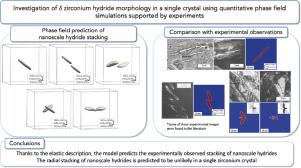Journal of Nuclear Materials ( IF 2.8 ) Pub Date : 2021-09-16 , DOI: 10.1016/j.jnucmat.2021.153303 P.-C.A. Simon 1, 2 , Larry K. Aagesen 2 , Andrea M. Jokisaari 2 , Long-Qing Chen 3 , Mark R. Daymond 4 , Arthur T. Motta 1 , Michael R. Tonks 5

|
In light water nuclear reactors, waterside corrosion of the cladding material leads to the production of hydrogen, a fraction of which is picked up by the zirconium cladding and precipitates into brittle hydride particles. These nanoscale hydride particles aggregate into mesoscale hydride clusters. The principal stacking direction of the nanoscale hydrides precipitated in the cladding tube changes from circumferential in the absence of applied stress to radial under circumferential applied stress. A quantitative phase field model has been developed to predict the hydride morphology observed experimentally and identify the mechanisms responsible for nanoscale hydride stacking. The model focuses on nanoscale hydride precipitation in a single zirconium grain with a detailed description of the anisotropic elastic contribution. The model predictions concerning the shape, orientation, and stacking behavior of nanoscale hydride are analyzed and compared with experimental observations. The model accurately accounts for the experimentally observed elongated nanoscale hydride shape and the stacking of hydrides along the basal plane of the hexagonal zirconium matrix. When investigating the role of applied stress in hydride morphology, the model challenges some of the mechanisms previously proposed to explain hydride reorientation. Although hydride reorientation has been hypothesized to be caused by a change in nanoscale hydride shape, the current study shows that these mechanisms are unlikely to occur.
中文翻译:

使用由实验支持的定量相场模拟研究单晶中的 δ 氢化锆形态
在轻水核反应堆中,包壳材料的水侧腐蚀导致产生氢气,其中一部分被锆包壳吸收并沉淀成脆性氢化物颗粒。这些纳米级氢化物颗粒聚集成中级氢化物簇。包壳管中析出的纳米级氢化物的主要堆积方向从无外加应力的周向变化为受周向外加应力的径向。已经开发了定量相场模型来预测实验观察到的氢化物形态并确定负责纳米级氢化物堆积的机制。该模型侧重于单个锆晶粒中的纳米级氢化物沉淀,并详细描述了各向异性弹性贡献。分析了关于纳米级氢化物的形状、取向和堆积行为的模型预测,并与实验观察进行了比较。该模型准确地解释了实验观察到的细长纳米级氢化物形状和氢化物沿六方锆基体基面的堆积。在研究外加应力在氢化物形态中的作用时,该模型挑战了先前提出的用于解释氢化物重新定向的一些机制。尽管已经假设氢化物重新定向是由纳米级氢化物形状的变化引起的,但目前的研究表明这些机制不太可能发生。该模型准确地解释了实验观察到的细长纳米级氢化物形状和氢化物沿六方锆基体基面的堆积。在研究外加应力在氢化物形态中的作用时,该模型挑战了先前提出的用于解释氢化物重新定向的一些机制。尽管假设氢化物重新定向是由纳米级氢化物形状的变化引起的,但目前的研究表明这些机制不太可能发生。该模型准确地解释了实验观察到的细长纳米级氢化物形状和氢化物沿六方锆基体基面的堆积。在研究外加应力在氢化物形态中的作用时,该模型挑战了先前提出的用于解释氢化物重新定向的一些机制。尽管假设氢化物重新定向是由纳米级氢化物形状的变化引起的,但目前的研究表明这些机制不太可能发生。











































 京公网安备 11010802027423号
京公网安备 11010802027423号